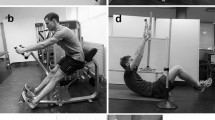Abstract
The purpose of this study was to investigate the effect of upper body 20-s or 180-s interval training, using a double poling ergometer, on upper body power output and selected physiological and biomechanical parameters in cross-country skiers. Twenty (12 male, 8 female) well-trained cross-country skiers took part. Two intervention groups, a 20-s interval training group (IT20; n=6) and a 180-s interval training group (IT180; n=7), underwent training three times a week for 6 weeks on a double poling ergometer. A third group served as a control (CON; n=7) and followed the same training program as the IT20 and IT180 groups without the double poling ergometer interval training. The IT20 and IT180 groups significantly (P<0.05) increased both peak and mean power in a 30-s test and mean power in a 6-min test after double poling training. There was a significant improvement in work efficiency in both IT20 and IT180 (P<0.05) and, in IT180, a significant reduction (P<0.05) in blood lactate concentration at given sub-maximal workloads. V̇O2peak increased significantly during double poling in IT180 (P<0.05) only. V̇O2max did not change significantly in either group. There were no significant changes in any of the test variables in CON. In conclusion, this study shows that 6 weeks of 20-s or 180-s double poling interval training, three times a week, significantly increases power output in both 30-s and 6-min tests, as well as in selected physiological and biomechanical parameters in well-trained cross-country skiers.



Similar content being viewed by others
References
Åstrand P-O, Rodahl K (1986) Textbook of work physiology. McGraw Hill, New York, pp 399–405
Bilodeau B, Roy B, Boulay MR (1995) Upper-body testing of cross-country skiers. Med Sci Sports Exerc 27:1557–1562
Bogdanis GC, Nevill ME, Boobis LH, Lakomy HKA (1996) Contribution of phosphocreatine and aerobic metabolism to energy supply during repeated sprint exercise. J Appl Physiol 80:876–884
Borg G, Ljunggren G, Ceci R (1985) The increase of perceived exertion, aches and pain in the legs, heart rate and blood lactate during exercise on a bicycle ergometer. Eur J Appl Physiol 54:343–349
Bulbulian R, Wilcox AR, Darabos BL (1986) Anaerobic contribution to distance running performance of trained cross-country athletes. Med Sci Sports Exerc 18:107–113
Hickson RC, Rosenkotter MA. Brown MM (1980) Strength training effects on aerobic power and short-term endurance. Med Sci Sports Exerc 12:336–339
Hickson RC, Dvorak BA, Gorostiaga EM, Kurowski TT, Foster C (1988) Potential for strength and endurance training to amplify endurance performance. J Appl Physiol 65:2285–2290
Hoff J, Helgerud J, Wisloff U (1999) Maximal strength training improves work economy in trained female cross-country skiers. Med Sci Sports Exerc 31:870–877
Jeukendrup A, Saris WHM, Brouns F, Kester ADM (1996) A new validated endurance test. Med Sci Sports Exerc 28:266–270
Laursen PB, Jenkins DG (2002) The scientific basis for high intensity interval training: optimising training programme and maximising performance in highly trained endurance athletes. Sports Med 32:53–73
Lindsay FH, Hawley JA, Myburgh KH, Shomer HH, Noakes TD, Dennis SC (1996) Improved athletic performance in highly trained cyclists after interval training. Med Sci Sports Exerc 28:1427–1434
Mahood NV, Kenefick RW, Kertzer R, Quinn TJ (2001) Physiological determinants of cross-country ski racing performance. Med Sci Sports Exerc 33:1379–1384
Mainwood GW, Renaud JM (1985) The effect of acid-base balance on fatigue of skeletal muscle. Can J Physiol Pharmacol 63:403–416
Mygind E, Andersen LB, Rasmussen B (1994) Blood lactate and respiratory variables in elite cross-country skiing at racing speeds. Scand J Med Sci Sports 4:243–251
Paavolainen LK, Häkkinen K, Nummela A, Rusko H (1999) Explosive-strength training improves 5-km running time by improving running economy and muscle power. J Appl Physiol 86:1527–1533
Rundell KW (1995) Treadmill roller ski test predicts biathlon roller ski race results of elite U.S. biathlon women. Med Sci Sports Exerc 27:1677–1685
Rusko H (2002) Physiology of cross country skiing. In: Rusko H (ed) Handbook of sports medicine and science – cross country skiing.. IOC Medical Commission, Blackwell, Oxford, pp.1–31
Rusko H, Havu M, Karvinen E (1978) Aerobic performance capacity in athletes. Eur J Appl Physiol Occup Physiol 38:151–159
Saltin B (1997) The physiology of competitive cross-country skiing across a four-decade perspective; with a note on training induced adaptations and role of training at medium altitude. In: Proceedings of the 1st International Congress on Skiing and Science, St. Christoph a. Arlberg, Austria. E&FN Spon, London, pp 435–469
Sharp RL, Costill DL, Fink WJ, King DS (1986) Effect of eight weeks of bicycle sprint training on human muscle buffer capacity. Int J Sports Med 7:13–17
Staib J L, Im J, Caldwell Z, Rundell KW (2000) Cross-country ski racing performance predicted by aerobic and anaerobic double poling power. J Strength Cond Res 14: 282–288
Stepto NK, Hawley JA, Dennis SC, Hopkins WG (1999) Effects of different interval-training programs on cycling time-trial performance. Med Sci Sports Exerc 31:736–741
Tanaka H, Bassett DR Jr, Swensen TC, Sampedro RM (1993) Aerobic and anaerobic power characteristics of competitive cyclists in the United States Cycling Federation. Int J Sports Med 14:334–338
Troup JP, Metzger JM, Fitts RH (1986) Effect of high-intensity exercise training on functional capacity of limb skeletal muscle. J Appl Physiol 60:1743–1751
Weston AR, Myburgh KH, Lindsay FH, Dennis SC, Noakes TD, Hawley JA (1997) Skeletal muscle buffering capacity and endurance performance after high-intensity interval training by well trained cyclists. Eur J Appl Physiol 75: 7–13
Acknowledgements
The investigation was supported by grants, which are gratefully acknowledged, from the Norwegian University of Sport and Physical Education in Oslo; University College of Physical Education and Sports in Stockholm, Sweden, and the Swedish Olympic Committee. We also thanks Erling Nordbo, Erlend Hem and Svein Leirstein for skilful technical assistance in the data collection.
Author information
Authors and Affiliations
Corresponding author
Rights and permissions
About this article
Cite this article
Nilsson, J.E., Holmberg, HC., Tveit, P. et al. Effects of 20-s and 180-s double poling interval training in cross-country skiers. Eur J Appl Physiol 92, 121–127 (2004). https://doi.org/10.1007/s00421-004-1042-4
Accepted:
Published:
Issue Date:
DOI: https://doi.org/10.1007/s00421-004-1042-4




